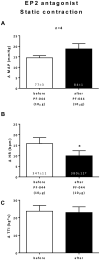Role of prostaglandins in spinal transmission of the exercise pressor reflex in decerebrated rats
- PMID: 25003710
- PMCID: PMC4164591
- DOI: 10.1016/j.neuroscience.2014.06.061
Role of prostaglandins in spinal transmission of the exercise pressor reflex in decerebrated rats
Abstract
Previous studies found that prostaglandins in skeletal muscle play a role in evoking the exercise pressor reflex; however the role played by prostaglandins in the spinal transmission of the reflex is not known. We determined, therefore, whether or not spinal blockade of cyclooxygenase (COX) activity and/or spinal blockade of endoperoxide (EP) 2 or 4 receptors attenuated the exercise pressor reflex in decerebrated rats. We first established that intrathecal doses of a non-specific COX inhibitor Ketorolac (100 μg in 10 μl), a COX-2-specific inhibitor Celecoxib (100 μg in 10 μl), an EP2 antagonist PF-04418948 (10 μg in 10 μl), and an EP4 antagonist L-161,982 (4 μg in 10 μl) effectively attenuated the pressor responses to intrathecal injections of arachidonic acid (100 μg in 10 μl), EP2 agonist Butaprost (4 ng in 10 μl), and EP4 agonist TCS 2510 (6.25 μg in 2.5 μl), respectively. Once effective doses were established, we statically contracted the hind limb before and after intrathecal injections of Ketorolac, Celecoxib, the EP2 antagonist and the EP4 antagonist. We found that Ketorolac significantly attenuated the pressor response to static contraction (before Ketorolac: 23 ± 5 mmHg, after Ketorolac 14 ± 5 mmHg; p<0.05) whereas Celecoxib had no effect. We also found that 8 μg of L-161,982, but not 4 μg of L-161,982, significantly attenuated the pressor response to static contraction (before L-161,982: 21 ± 4 mmHg, after L-161,982 12 ± 3 mmHg; p<0.05), whereas PF-04418948 (10 μg) had no effect. We conclude that spinal COX-1, but not COX-2, plays a role in evoking the exercise pressor reflex, and that the spinal prostaglandins produced by this enzyme are most likely activating spinal EP4 receptors, but not EP2 receptors.
Keywords: cyclooxygenase; endoperoxide receptors; static contraction; sympathetic nervous system; thin fiber muscle afferents.
Copyright © 2014 IBRO. Published by Elsevier Ltd. All rights reserved.
Figures





Similar articles
-
Cyclooxygenase products contribute to the exaggerated exercise pressor reflex evoked by static muscle contraction in male UCD-type 2 diabetes mellitus rats.J Appl Physiol (1985). 2024 May 1;136(5):1226-1237. doi: 10.1152/japplphysiol.00879.2023. Epub 2024 Mar 28. J Appl Physiol (1985). 2024. PMID: 38545661 Free PMC article.
-
Combined, but not individual, blockade of ASIC3, P2X, and EP4 receptors attenuates the exercise pressor reflex in rats with freely perfused hindlimb muscles.J Appl Physiol (1985). 2015 Dec 1;119(11):1330-6. doi: 10.1152/japplphysiol.00630.2015. Epub 2015 Oct 15. J Appl Physiol (1985). 2015. PMID: 26472871 Free PMC article.
-
Endoperoxide 4 receptors play a role in evoking the exercise pressor reflex in rats with simulated peripheral artery disease.J Physiol. 2013 Jun 1;591(11):2949-62. doi: 10.1113/jphysiol.2012.247973. Epub 2013 Apr 8. J Physiol. 2013. PMID: 23568893 Free PMC article.
-
Prostaglandins and cyclooxygenases [correction of cycloxygenases] in the spinal cord.Prog Neurobiol. 2001 Jul;64(4):327-63. doi: 10.1016/s0301-0082(00)00063-0. Prog Neurobiol. 2001. PMID: 11275357 Review.
-
Mechanosensitive channels in the mechanical component of the exercise pressor reflex.Auton Neurosci. 2023 Dec;250:103128. doi: 10.1016/j.autneu.2023.103128. Epub 2023 Oct 29. Auton Neurosci. 2023. PMID: 37925831 Review.
Cited by
-
Role played by interleukin-6 in evoking the exercise pressor reflex in decerebrate rats: effect of femoral artery ligation.Am J Physiol Heart Circ Physiol. 2015 Jul 1;309(1):H166-73. doi: 10.1152/ajpheart.00195.2015. Epub 2015 Apr 24. Am J Physiol Heart Circ Physiol. 2015. PMID: 25910806 Free PMC article.
-
Gene and protein expression of dorsal root ganglion sensory receptors in normotensive and hypertensive male rats.Am J Physiol Regul Integr Comp Physiol. 2022 Aug 1;323(2):R221-R226. doi: 10.1152/ajpregu.00007.2022. Epub 2022 May 24. Am J Physiol Regul Integr Comp Physiol. 2022. PMID: 35608265 Free PMC article.
-
Inhibition of cyclooxygenase attenuates the blood pressure response to plantar flexion exercise in peripheral arterial disease.Am J Physiol Heart Circ Physiol. 2015 Aug 1;309(3):H523-8. doi: 10.1152/ajpheart.00267.2015. Epub 2015 Jun 8. Am J Physiol Heart Circ Physiol. 2015. PMID: 26055794 Free PMC article.
-
Cyclooxygenase products contribute to the exaggerated exercise pressor reflex evoked by static muscle contraction in male UCD-type 2 diabetes mellitus rats.J Appl Physiol (1985). 2024 May 1;136(5):1226-1237. doi: 10.1152/japplphysiol.00879.2023. Epub 2024 Mar 28. J Appl Physiol (1985). 2024. PMID: 38545661 Free PMC article.
References
-
- Adreani CM, Hill JM, Kaufman MP. Intrathecal blockade of both NMDA and non-NMDA receptors attenuates the exercise pressor reflex in cats. JApplPhysiol. 1996;80:315–322. - PubMed
-
- Bar KJ, Natura G, Telleria-Diaz A, Teschner P, Vogel R, Vasquez E, Schaible HG, Ebersberger A. Changes in the effect of spinal prostaglandin E2 during inflammation: prostaglandin E (EP1-EP4) receptors in spinal nociceptive processing of input from the normal or inflamed knee joint. J Neurosci. 2004;24:642–651. - PMC - PubMed
-
- Beiche F, Scheuerer S, Brune K, Geisslinger G, Goppelt-Struebe M. Up-regulation of cyclooxygenase-2 mRNA in the rat spinal cord following peripheral inflammation. FEBS Lett. 1996;390:165–169. - PubMed
Publication types
MeSH terms
Substances
Grants and funding
LinkOut - more resources
Full Text Sources
Other Literature Sources
Research Materials

